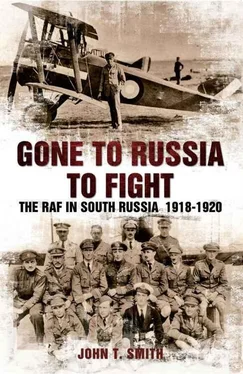But the first British troops into south Russia were from the 14th Indian Army Division stationed in Iraq and Persia. On 17 November 1918, six days after the end of the First World War, Major General Thompson, who had replaced General Dunsterville, reoccupied Baku as the Turks withdrew. Escorted by the five armed ships under the command of Captain Washington, a convoy of seventeen merchant ships landed 2,000 British troops in the port at Baku. Another British Army force from Salonika occupied the port of Batum on the Black Sea. These two ports were connected by a rail line that ran along the southern line of the Caucasus Mountains, through the city of Tiflis. The supply problems for the British ships on the Caspian were reduced by this rail and sea link to the Mediterranean. The British occupation of the Transcaucasus region was intended to bring stability to the area of the largest oil-fields in the world, as well as to ease supply problems. It was also intended to disarm the area as the Turkish Army withdrew. But the number of British troops remained tiny in the context of the troubles in the region.
The British cabinet had taken the decision on 14 November to contact General Denikin and to provide him with military equipment and training. Major-General Frederick Poole had been recalled from the British forces in north Russia and it was decided to place him in command of the British Military Mission to General Denikin. The capture of Novorossisk by General Denikin’s Volunteer Army, in late 1918, had given them an outlet to the sea. Taking advantage of this, General Poole arrived in Novorossisk in December 1918. The relations between General Denikin and the Don Cossacks had never been particularly warm, although they had worked together against the Red forces. But General Poole, with promises of enormous amounts of British money and equipment, forced the Don Cossacks under their Ataman General Peter Krasnov to place their forces under the command of General Denikin.

Tanks being delivered on the docks at Novorossisk.
To support the British Army and Navy forces in the area, the RAF began to gather together units to send into south Russia. Number 17 Squadron was stationed in Salonika and had taken part in the Bulgarian campaign. In the middle of September, A Flight had its Armstrong Witworth aircraft replaced by DH9s. Under the command of Captain A. D. Makins, A Flight left Salonika on 31 December for the port of Batum.
Number 221 Squadron was also sent into south Russia. Stationed on Mudros at the end of the war was Major John Oliver Andrews; writing in the 1920s, he recalled the squadron’s journey:
In November 1918, the Dardanelles being opened, a squadron of DH9s was formed to proceed to S. Russia, with the idea of co-operating with the Naval forces on the Caspian Sea, and with the Russian White Armies operation under Denikin in the Caucasus. It was difficult to raise the necessary other rank personnel, due partly to the demoralisation and war weariness caused by the long sojourn in Mudros and Imbros… In December, the unit, 221 Squadron, embarked in the S. S. Riviera , and proceeded via Constantinople and the Black Sea to Batum. The passage was uneventful, except for New Year’s Eve spent at Constantinople with the R. N. R. and a spell of coal trimming and stoking undertaken by the squadron in the Black Sea, as the ship was short handed. It was universally agreed that coal shovelling in a ship’s bunker is a poor way of making a livelihood. [1]
221 Squadron was to be part of 62 Wing, made up of 221 Squadron equipped with DH9s, and (later) DH9As; 266 Squadron equipped with Short 184 floatplanes; and 186 Squadron, to be equipped with Handley Page bombers. In the event, 186 Squadron never arrived.
Also stationed at Mudros at the end of the war was D. B. Knock, an armourer. In his diary, published in the 1930s, he described Major Andrews:
20/12/18 Remnants of Squadron re-formed as 221 Squadron RAF, with Major Andrews as CO. Things brushed up and discipline tightened up. Andrews won’t stand any nonsense. A soldier from head to feet… Have heard of his record in France with somewhere around 40 EA [enemy aircraft] to his credit [if aircraft driven down are included, Andrews’ total was 24 EA]. Didn’t get his DSO and MC for nothing. A pre-war soldier before RFC. [2]
D. B. Knock also related his experiences on the journey to Batum in his diary. He seems to have agreed with Andrews on the coal shovelling:
28/12/18 Orders to be ready to move early morning. Nobody knows really where, but rumours say Constantinople. Be great to see the city of Mosques. ’Planes, motor transport, ammunition, etc. all ready.
29/12/18 HQ staff and A Flight board HMS “Riviera” (seaplane carrier). At midnight. Sail at 2am. We enter Dardanelles at 8am… Reach Constantinople at 9pm.
31/12/18 Not allowed ashore. Instead we help Navy stokers to coal from a collier moored alongside. Get as black as Hades drill slacks and tunic so black I trade them with a stoker for rum. He can wash them! Leave Bosphorus 8am and out into Black Sea. Wonderful sight that waterway is. 1919 breaks with a blue sea and the sight of HMS “Superb” at 10am making from somewhere, probably Odessa. For Constantinople. [500 British marines had been landed in Sevastopol] [3]
Another member of 221 Squadron was Lieutenant O. R. Gayford, an observer, who had earlier taken part in the bombing of Constantinople. He also described the journey:
By December 1918 the Squadron was completely equipped with Puma DH9s, [Major Andrews took one Bentley-engined Sopwith Camel with him for his own personal use] and was preparing to go up to the Caspian Sea for work with a naval squadron, which was on those inland waters. We left by Flights at intervals of about a fortnight in seaplane carriers via the Bosphorus to Batum on the Black Sea. Our aircraft were taken with engines installed and with undercarriages on, but wings and empennages dismantled. [4]
By the end of 1918, 221 Squadron had started the move into the Caucasus, but it was to be early 1919 before 266 Squadron, the seaplane squadron, joined them. The British Naval ships on the Caspian were active during December. On 8 December, two British ships, the Zoro-Aster and the Alla Verdi , were at anchor off Chechen Island, north of Baku, when three Bolshevik navy vessels were seen escorting three merchant ships. The Bolsheviks opened fire on the British ships, which left their moorings and chased the Red vessels. Hits were seen on the enemy ships, while three shells hit the Zoro-Aster . The Red vessels escaped, but in their first encounter the British ships had seen off a superior enemy with no losses. On 29 December, four of the British ships bombarded the Bolshevik base at Staro-Terechnaya. The British flotilla was now up to a strength of eight armed ships.
By the end of 1918, contact had been established with General Denikin to find out his military needs, and a small force of British troops had occupied the south Caucasus region.
CHAPTER FIVE
JANUARY 1919
The military situation in the north Caucasus at the start of 1919 was that the Don Cossack Army was stretched thinly across the Don region. With the withdrawal of the German forces from the Ukraine, the Don Cossacks had lost their main source of weapons and support. General Krasnov, the Cossack leader, had identified himself too closely with the Germans, out of necessity, and his position was weakened with their removal. The Cossacks had reached the limits of their resources and the Red Southern Army Group had been built up to a force of 117,000 men, facing 40,000 Cossacks. Under this increased pressure from the north, the Cossacks were forced to retreat. The agreement giving General Denikin overall command was signed on 8 January by the Don Cossack leadership. The Armed Forces of South Russia was formed out of the Volunteer Army, the Don Cossacks, the Kuban Cossacks, and the Terek Cossacks.
Читать дальше













